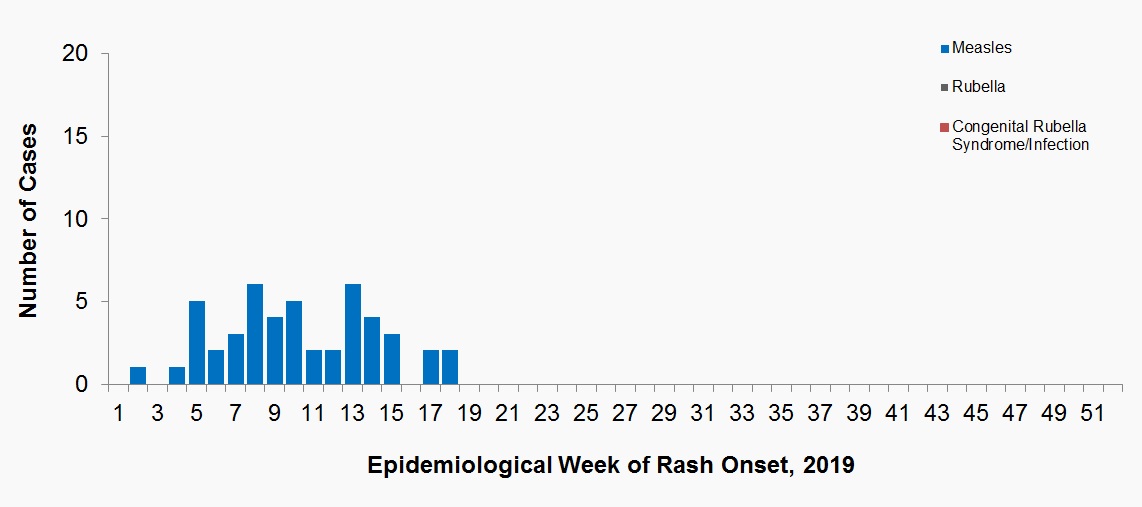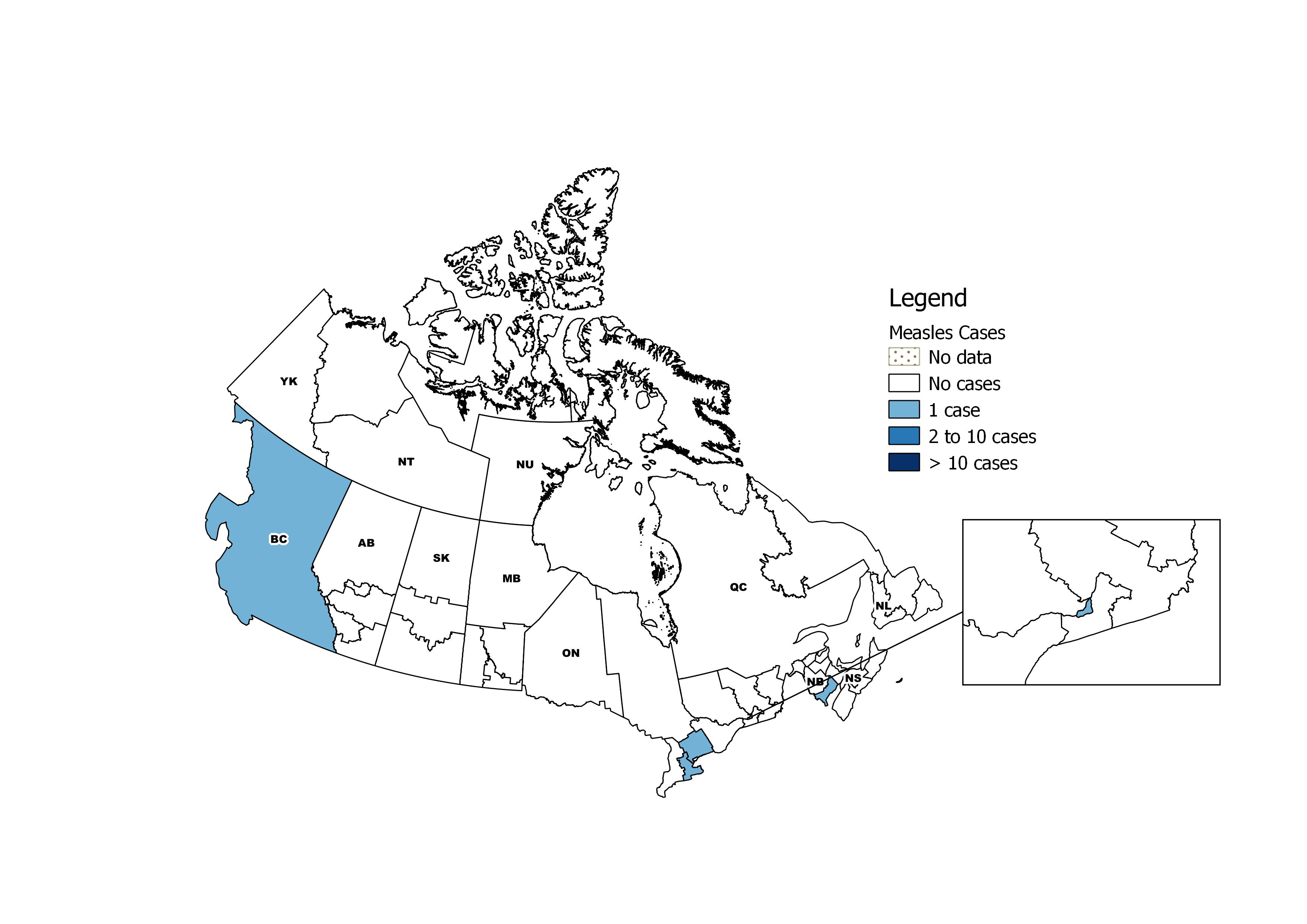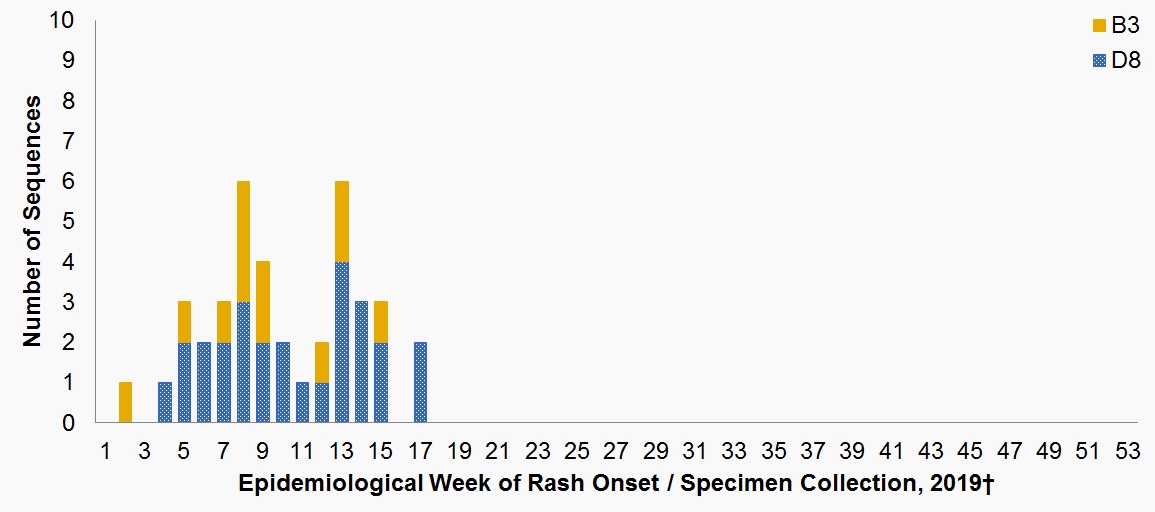Measles & Rubella Weekly Monitoring Report – Week 18: April 28 to May 4, 2019
Key Points
- In Canada, three new cases of measles and no new cases of rubella were reported in week 18, 2019.
- Currently, there are five activeFootnote 1 cases of measles in Canada.
- Forty-eight (48) cases of measles and no cases of rubella have been reported in Canada in 2019. These cases were reported by Québec, British Columbia, the Northwest Territories, Ontario, Alberta, and New Brunswick.
- Globally, there are large measles outbreaks which have affected a large number of countries. Canadians travelling outside of Canada are invited to consult the travel health notices for more information.
Organization: Public Health Agency of Canada
Date published: 2019-05-17
On this page
Epidemiological summary
During epidemiological week 18, 2019 three new confirmed cases of measles and no new cases of rubella were reported in CanadaFootnote 2. The first case reported by the province of Québec, with rash onset in epidemiological week 18, was exposed to an unknown source but reported recent travel to France. The second case reported by the province of British Columbia was acquired while travelling to the United States and Japan, with rash onset in epidemiological week 17. The third case reported by the province of Ontario was acquired while traveling to the Philippines, with rash onset in epidemiological week 18.
To date in 2019, 48 cases of measles and no cases of rubella have been reported. The last case of rubella was reported in 2016 and the last case of congenital rubella syndrome/infection was reported in September 2018.
Figure 1: Number of cases of measles (n=48), rubella (n=0), and congenital rubella syndrome (n=0)Footnote 3 by week of rash onset, as reported to the Canadian Measles/Rubella Surveillance System (CMRSS) and Measles and Rubella Surveillance System (MARS), for the period ending May 4, 2019.

Figure 1 - Text equivalent
| Epidemiological Week of Rash Onset, 2019 | Number of confirmed measles cases reported | Number of confirmed rubella cases reported | Number of confirmed congenital rubella syndrome/infection cases reported |
|---|---|---|---|
| 1 | 0 | 0 | 0 |
| 2 | 1 | 0 | 0 |
| 3 | 0 | 0 | 0 |
| 4 | 1 | 0 | 0 |
| 5 | 5 | 0 | 0 |
| 6 | 2 | 0 | 0 |
| 7 | 3 | 0 | 0 |
| 8 | 6 | 0 | 0 |
| 9 | 4 | 0 | 0 |
| 10 | 5 | 0 | 0 |
| 11 | 2 | 0 | 0 |
| 12 | 2 | 0 | 0 |
| 13 | 6 | 0 | 0 |
| 14 | 4 | 0 | 0 |
| 15 | 3 | 0 | 0 |
| 16 | 0 | 0 | 0 |
| 17 | 2 | 0 | 0 |
| 18 | 2 | 0 | 0 |
| 19 | 0 | 0 | 0 |
| 20 | 0 | 0 | 0 |
| 21 | 0 | 0 | 0 |
| 22 | 0 | 0 | 0 |
| 23 | 0 | 0 | 0 |
| 24 | 0 | 0 | 0 |
| 25 | 0 | 0 | 0 |
| 26 | 0 | 0 | 0 |
| 27 | 0 | 0 | 0 |
| 28 | 0 | 0 | 0 |
| 29 | 0 | 0 | 0 |
| 30 | 0 | 0 | 0 |
| 31 | 0 | 0 | 0 |
| 32 | 0 | 0 | 0 |
| 33 | 0 | 0 | 0 |
| 34 | 0 | 0 | 0 |
| 35 | 0 | 0 | 0 |
| 36 | 0 | 0 | 0 |
| 37 | 0 | 0 | 0 |
| 38 | 0 | 0 | 0 |
| 39 | 0 | 0 | 0 |
| 40 | 0 | 0 | 0 |
| 41 | 0 | 0 | 0 |
| 42 | 0 | 0 | 0 |
| 43 | 0 | 0 | 0 |
| 44 | 0 | 0 | 0 |
| 45 | 0 | 0 | 0 |
| 46 | 0 | 0 | 0 |
| 47 | 0 | 0 | 0 |
| 48 | 0 | 0 | 0 |
| 49 | 0 | 0 | 0 |
| 50 | 0 | 0 | 0 |
| 51 | 0 | 0 | 0 |
| 52 | 0 | 0 | 0 |
| Missing Rash Onset | 0 | 0 | 0 |
| Cases (year-to-date) | 48 | 0 | 0 |
Geographic distribution
There are currently five activeFootnote * cases of measles reported in Canada.
Figure 2: Distribution of activeFootnote *, confirmed measles cases by health region.

Figure 2 - Text equivalent
| Health Region | Measles Active Cases |
|---|---|
| Eastern Regional Integrated Health Authority | 0 |
| Central Regional Integrated Health Authority | 0 |
| Western Regional Integrated Health Authority | 0 |
| Labrador-Grenfell Regional Integrated Health Authority | 0 |
| Prince Edward Island | 0 |
| South Shore District Health Authority | 0 |
| South West Nova District Health Authority | 0 |
| Annapolis Valley District Health Authority | 0 |
| Colchester East Hants Health Authority | 0 |
| Cumberland Health Authority | 0 |
| Pictou County Health Authority | 0 |
| Guysborough Antigonish Strait Health Authority | 0 |
| Cape Breton District Health Authority | 0 |
| Capital District Health Authority | 0 |
| Zone 1 (NB) | 0 |
| Zone 2 (NB) | 1 |
| Zone 3 (NB) | 0 |
| Zone 4 (NB) | 0 |
| Zone 5 (NB) | 0 |
| Zone 6 (NB) | 0 |
| Zone 7 (NB) | 0 |
| Québec et Chaudières-Appalaches | 0 |
| Centre-du-Québec | 0 |
| Montréal et Laval | 1 |
| Ouest-du-Québec | 0 |
| Montérégie | 0 |
| Nord-Est | 0 |
| Ontario Central East | 1 |
| Ontario Central West | 1 |
| Ontario Eastern | 0 |
| Ontario North East | 0 |
| Ontario North West | 0 |
| Ontario South West | 0 |
| City of Toronto Health Unit | 0 |
| Winnipeg Regional Health Authority | 0 |
| Prairie Mountain Health | 0 |
| Interlake-Eastern Regional Health Authority | 0 |
| Northern Regional Health Authority | 0 |
| Southern Health | 0 |
| Saskatchewan South | 0 |
| Saskatchewan Central | 0 |
| Saskatchewan North | 0 |
| South Zone | 0 |
| Calgary Zone | 0 |
| Central Zone | 0 |
| Edmonton Zone | 0 |
| North Zone | 0 |
| British Columbia | 1 |
| Yukon | 0 |
| Northwest Territories | 0 |
| Nunavut | 0 |
|
|
- Footnote *
-
Active cases or outbreaks are those in which the onset date of the most recent case/outbreak-associated case falls within 32 days of the issue date of this reportFootnote 4.
Laboratory summary
Measles
In 2019, thirty-nine (39) cases of measles have been genotyped and the genotypes were B3 (n=12) and D8 (n=27), both of which are circulating globally.
In week 18, two measles cases were genotyped and both cases were genotype D8. One case, reported by the province of New Brunswick, with rash onset in epidemiological week 17 and travel history to several countries in Europe, was identical to the WHO named strain MVs/Gir Somnath.IND/42.16/ (GenBank accession number KY120864), which is circulating globally. The second genotype D8 case was reported by the province of British Columbia, with rash onset in epidemiological week 17 and travel history to the United States and Japan, but was not identical to a named strain.
Figure 3: Distribution of measles genotypes detected in 2019 (n=39) by week† of rash onset.

Figure 3 - Text equivalent
| Epi week | B3 | B3 - Harare | D4 | D8 | D8 - Taunton | D9 | H1 | Total |
|---|---|---|---|---|---|---|---|---|
| 1 | 0 | 0 | 0 | 0 | 0 | 0 | 0 | 0 |
| 2 | 1 | 0 | 0 | 0 | 0 | 0 | 0 | 1 |
| 3 | 0 | 0 | 0 | 0 | 0 | 0 | 0 | 0 |
| 4 | 0 | 0 | 0 | 1 | 0 | 0 | 0 | 1 |
| 5 | 1 | 0 | 0 | 2 | 0 | 0 | 0 | 3 |
| 6 | 0 | 0 | 0 | 2 | 0 | 0 | 0 | 2 |
| 7 | 1 | 0 | 0 | 2 | 0 | 0 | 0 | 3 |
| 8 | 3 | 0 | 0 | 3 | 0 | 0 | 0 | 6 |
| 9 | 2 | 0 | 0 | 2 | 0 | 0 | 0 | 4 |
| 10 | 0 | 0 | 0 | 2 | 0 | 0 | 0 | 2 |
| 11 | 0 | 0 | 0 | 1 | 0 | 0 | 0 | 1 |
| 12 | 1 | 0 | 0 | 1 | 0 | 0 | 0 | 2 |
| 13 | 2 | 0 | 0 | 4 | 0 | 0 | 0 | 6 |
| 14 | 0 | 0 | 0 | 3 | 0 | 0 | 0 | 3 |
| 15 | 1 | 0 | 0 | 2 | 0 | 0 | 0 | 3 |
| 16 | 0 | 0 | 0 | 0 | 0 | 0 | 0 | 0 |
| 17 | 0 | 0 | 0 | 2 | 0 | 0 | 0 | 2 |
| 18 | 0 | 0 | 0 | 0 | 0 | 0 | 0 | 0 |
| 19 | 0 | 0 | 0 | 0 | 0 | 0 | 0 | 0 |
| 20 | 0 | 0 | 0 | 0 | 0 | 0 | 0 | 0 |
| 21 | 0 | 0 | 0 | 0 | 0 | 0 | 0 | 0 |
| 22 | 0 | 0 | 0 | 0 | 0 | 0 | 0 | 0 |
| 23 | 0 | 0 | 0 | 0 | 0 | 0 | 0 | 0 |
| 24 | 0 | 0 | 0 | 0 | 0 | 0 | 0 | 0 |
| 25 | 0 | 0 | 0 | 0 | 0 | 0 | 0 | 0 |
| 26 | 0 | 0 | 0 | 0 | 0 | 0 | 0 | 0 |
| 27 | 0 | 0 | 0 | 0 | 0 | 0 | 0 | 0 |
| 28 | 0 | 0 | 0 | 0 | 0 | 0 | 0 | 0 |
| 29 | 0 | 0 | 0 | 0 | 0 | 0 | 0 | 0 |
| 30 | 0 | 0 | 0 | 0 | 0 | 0 | 0 | 0 |
| 31 | 0 | 0 | 0 | 0 | 0 | 0 | 0 | 0 |
| 32 | 0 | 0 | 0 | 0 | 0 | 0 | 0 | 0 |
| 33 | 0 | 0 | 0 | 0 | 0 | 0 | 0 | 0 |
| 34 | 0 | 0 | 0 | 0 | 0 | 0 | 0 | 0 |
| 35 | 0 | 0 | 0 | 0 | 0 | 0 | 0 | 0 |
| 36 | 0 | 0 | 0 | 0 | 0 | 0 | 0 | 0 |
| 37 | 0 | 0 | 0 | 0 | 0 | 0 | 0 | 0 |
| 38 | 0 | 0 | 0 | 0 | 0 | 0 | 0 | 0 |
| 39 | 0 | 0 | 0 | 0 | 0 | 0 | 0 | 0 |
| 40 | 0 | 0 | 0 | 0 | 0 | 0 | 0 | 0 |
| 41 | 0 | 0 | 0 | 0 | 0 | 0 | 0 | 0 |
| 42 | 0 | 0 | 0 | 0 | 0 | 0 | 0 | 0 |
| 43 | 0 | 0 | 0 | 0 | 0 | 0 | 0 | 0 |
| 44 | 0 | 0 | 0 | 0 | 0 | 0 | 0 | 0 |
| 45 | 0 | 0 | 0 | 0 | 0 | 0 | 0 | 0 |
| 46 | 0 | 0 | 0 | 0 | 0 | 0 | 0 | 0 |
| 47 | 0 | 0 | 0 | 0 | 0 | 0 | 0 | 0 |
| 48 | 0 | 0 | 0 | 0 | 0 | 0 | 0 | 0 |
| 49 | 0 | 0 | 0 | 0 | 0 | 0 | 0 | 0 |
| 50 | 0 | 0 | 0 | 0 | 0 | 0 | 0 | 0 |
| 51 | 0 | 0 | 0 | 0 | 0 | 0 | 0 | 0 |
| 52 | 0 | 0 | 0 | 0 | 0 | 0 | 0 | 0 |
| Total | 12 | 0 | 0 | 27 | 0 | 0 | 0 | 39 |
|
||||||||
The current global distribution of measles genotypes can be found on the WHO Measles Surveillance website.
For information regarding the interpretation and use of measles genotyping (including a discussion of genotypes and named strains), refer to Hiebert J and Severini A. Canada Communicable Disease Report. 2014; 40-12: 257-260.
- Footnote 1
-
Active cases or outbreaks are those in which the onset date of the most recent case/outbreak-associated case falls within 32 days of the issue date of this report.
- Footnote 2
-
Only cases with rash onset up to the indicated end date are included in this report. Any additional cases will be described in future reports.
- Footnote 3
-
Epidemiological week of birth is used for congenital rubella syndrome cases.
- Footnote 4
-
Public Health Agency of Canada. Guidelines for the prevention and control of measles outbreaks in Canada. Canadian Communicable Disease Report. 2013. Vol. 39: Definitions: conclusion of an outbreak (p. 5).